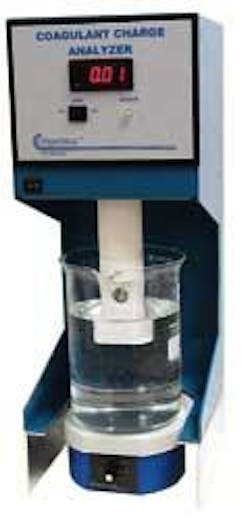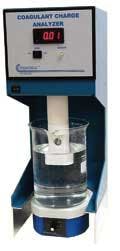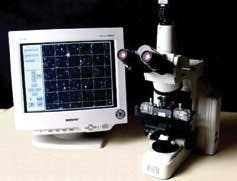Lab SCM Helps Define Best Coagulation Chemistry
By Robert L. Bryant and T. Mark Vandiver
Water and Wastewater plants have successfully used streaming current monitors (SCM) for on-line coagulant and polymer control for over 25 years. Until recently, operators have not had a convenient method to verify the on-line unit operation and/or response to process changes.
As with any instrument, when the reading or output changes, operators need to know if it is due to a process change, or if something is wrong with the instrument. Also, if the operator makes a chemical pump adjustment and the on-line SCM doesn't respond accordingly, there could be problems with the pump, an empty feed tank, etc., and nothing wrong with the instrument. Operators need to know something is wrong and have quick troubleshooting methods. The lab SCM gives them that tool. The lab unit is also a great tool for operators to see how changes such as pH, alkalinity, turbidity, mixing time, and chemical dosages affect the SC reading.
Background
Jar tests have been used for years to "ballpark" coagulant dose. Jar tests have limitations in that they are time consuming, intermittent, and are subject to variations in operator's visual observations. To help improve coagulant demand calculations, zeta meters (ZM) have been used to improve jar tests results. Zeta potential is a measure of particle surface charge. Prior to the advent of steaming current monitors, zeta meters were the primary instruments for measuring electrokinetic properties as related to coagulant dose. Both instruments measure charge, but use very different methods.
The zeta meter uses a stereoscopic microscope to observe particle movement through a glass cell called an electrophoresis cell. Electrodes in each end of the cell create an electric field. Particles possessing a positive charge (+) will move toward the anode (-), and negative particles (-) toward the cathode (+), Particle speed and direction is related to its zeta potential (ZP).
The ZP corresponding to optimum coagulant dose varies from plant to plant. It is important to understand that a ZP of zero is hardly ever the optimum value! The goal is to lower repulsive forces to the point where particle collisions causes agglomeration, and achieves the optimum particle size/density resulting in the best flocculation, sedimentation, and filtration. This "net charge" value could be negative, zero, or positive, but usually negative. ZP is normally expressed in millivolts. An optimum charge might be from -10 to -5 millivolts, for example.
The streaming current monitor is a charge measuring device. The charge measured is the net ionic and colloidal surface charge (positive and negative) in the sample being tested. Streaming current is related to zeta potential by the formula:
i _ ZD/N
where i = streaming current, Z = zeta potential, D = dielectric constant, and N = viscosity of the fluid.
The treated sample flows into the chamber where it is drawn into the bore during the piston upstroke and is expelled on the downstroke. Particles in the sample are temporarily immobilized on the piston and cylinder surfaces. As the water is moved back and forth, mobile counterions surrounding these particles are moved downstream to the electrodes. This reciprocating movement of like charges causes an alternating current to be generated which is defined as "streaming current (SC)." This current is amplified through the appropriate electronics and displayed as the SC value.
Streaming current is actually another method to measure ZP. However, the measured numerical values are not the same. A ZP of -10 MV, for instance, is not -10 SC units. This presents no problem in actual use since the optimum treatment program is always empirically determined for each plant.
As previously stated, in turbidity removal, the goal is to achieve optimum particle size/density. For organics removal, in "enhanced coagulation," optimum dosage may not even be related to particle collisions and floc development. This provides a definite advantage over zeta meters, which rely on visual observation of particles.
"Optimum" coagulation chemistry is generally defined as "the lowest dosage of all chemicals that results in the desired removal of contaminants with the lowest total operating costs." The on-line SCM can provide this optimization when properly installed, maintained, and interpreted.
Lab SCM Uses
Using a simple titration procedure, the lab SCM is used to correlate "best jar" with a quantified charge value and optimum plant performance. This provides a quick, visible way for operators to understand the relationship between water quality and SC. Once this correlation is established, jar tests usually becomes less frequent or unnecessary. If the plant has an on-line SCM, the lab unit serves as a periodic verification of its operation just like a lab pH meter, or turbidity meter does for on-line instruments. The lab SCM can also be a useful tool for comparing strength/activity of different coagulants/polymers prior to full-scale trials.
Staff at Athens, GA, provided the following conclusions after their purchase of a laboratory SCM – the Coagulant Charge Analyzer 3100 (CCA 3100):
• An effective tool for verifying jar tests required by a changing river water source. The unit also helped operators rapidly (less than five minutes) determine the optimum coagulant dose for their secondary water source – Bear Creek Reservoir.
• The laboratory unit verified operation of the plant's on-line streaming current monitors that automatically control the plant's coagulant feed pump.
• The plant reduced total chemical usage during the evaluation.
• Operators found the laboratory unit easy to use and a help during high turbidity excursions and when switching between two different water sources.
Conclusion
From an operator's perspective, streaming current provides the best on-line tool for optimizing and controlling coagulant dose. With the development of laboratory SCMs, operators can verify on-line operation and determine coagulant dose quicker than performing jar tests. The combination of on-line and laboratory units help to define the best coagulation for a changing water source.
About the Authors:
Bob Bryant is President of Chemtrac Systems, Inc. He began his career with Nalco Chemical, in 1969, and founded Chemtrac Systems in 1985. He introduced streaming current technology to the water treatment industry in 1982, holds several patents on water instrumentation devices, and has written over 20 articles for technical publications. Mark Vandiver is Manager of Market Development at Chemtrac Systems, and has 15 years of experience in water & wastewater treatment/testing.


